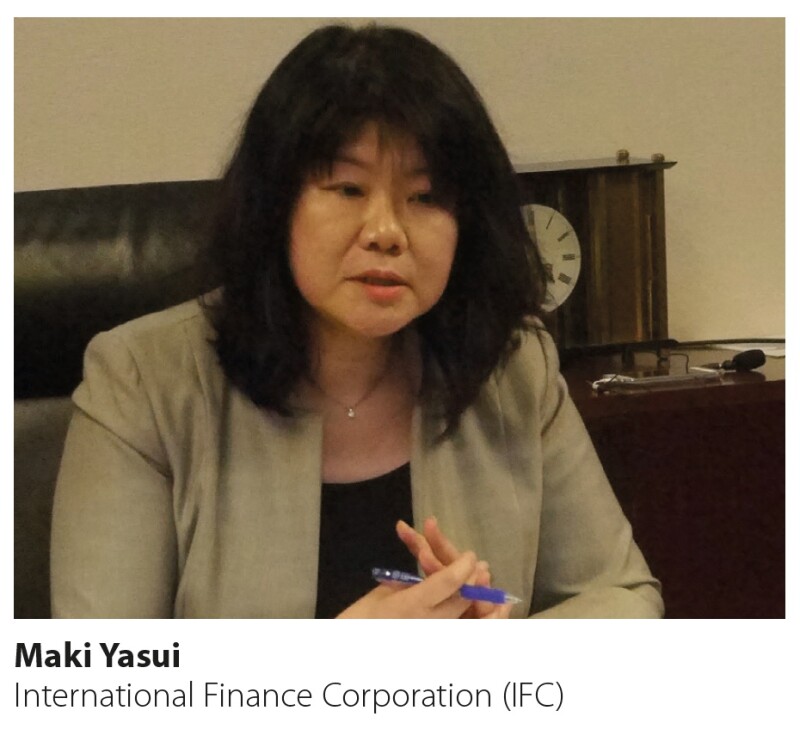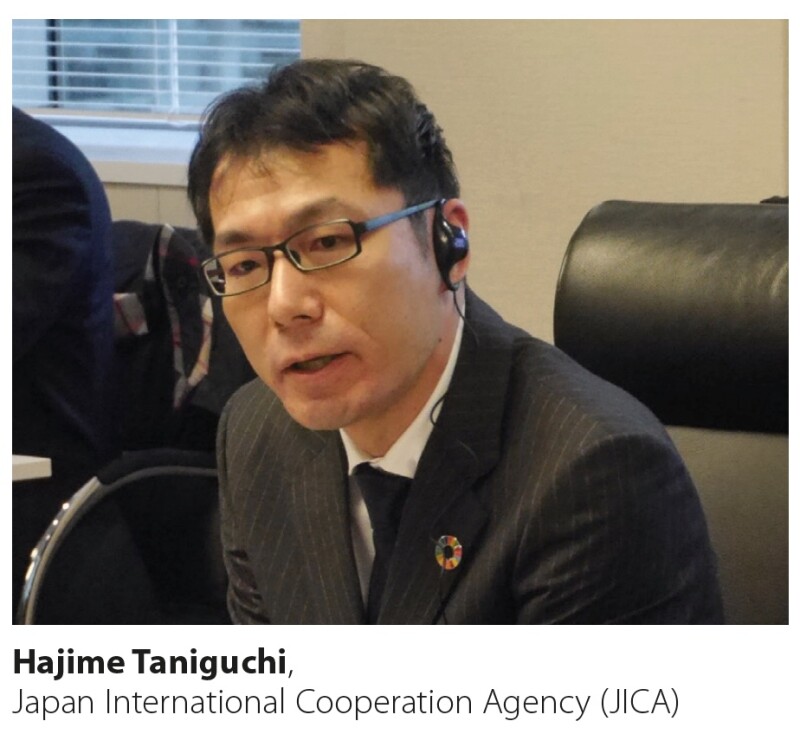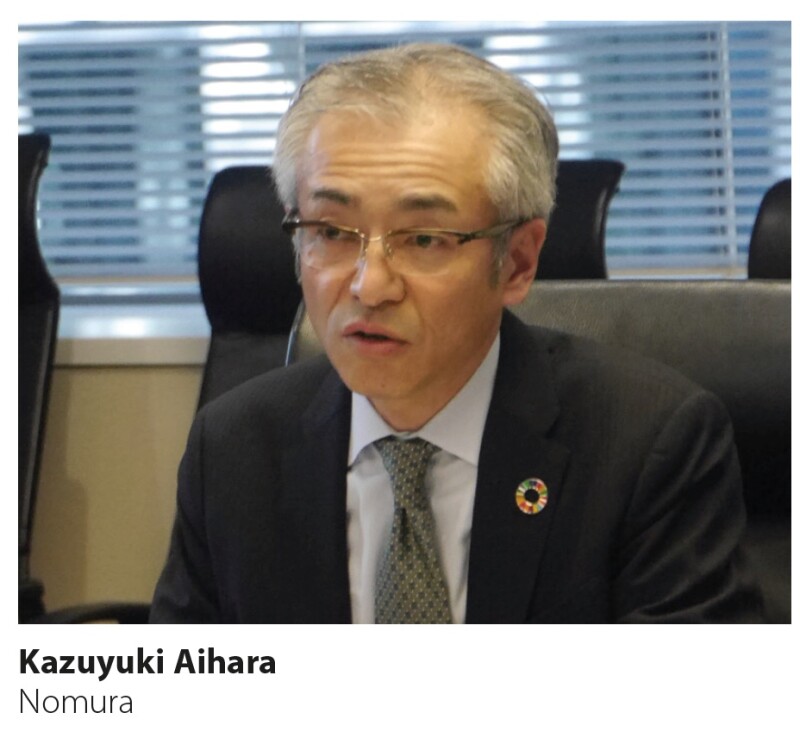
Participants in the roundtable were:
Kazuyuki Aihara, head of ESG products, debt capital markets department, Nomura
Shin Kasahara, executive director, international debt syndicate, Nomura
Naoki Kitamura, chief financial officer, Miraca Holdings
Yasuhiro Matsui, director general, treasury department, Development Bank of Japan (DBJ)
Masato Takebayashi, associate director, Asia Pacific research, Sustainalytics
Hajime Taniguchi, director, capital markets division, Japan International Cooperation Agency (JICA)
Maki Yasui, senior financial officer, treasury, International Finance Corporation (IFC)
Moderator: Matthew Thomas, Asia bureau chief, GlobalCapital Asia
GlobalCapital: How important are social bonds for Japanese issuers at the moment? What needs to be done to move this market forward?
Kazuyuki Aihara, Nomura: In 2019, the social bond market grew a lot in Japan. There was about ¥1,410bn ($13bn) of issuance in Japan’s domestic SRI market last year, but around ¥460bn of that came from social bonds. The green bond market has grown rapidly by receiving a lot of attention, including subsidies, but the social bond market has grown without any help.
2019 was a landmark year for this market. Issuers clearly see the value in using social bonds as part of their wider funding plan but, just as importantly, investors are really starting to welcome these deals. Since the emergence of the UN’s Sustainable Development Goals (SDGs), and the wider rise of ESG, investors now have a much deeper understanding of social bonds. Investor awareness has been improving for the past two or three years and it’s starting to make a big difference now.

It’s always tough to compare investors in different markets but in some ways it is clear that Japanese investors already have a better understanding of social bonds than a lot of investors overseas. There is plenty of room for improvement. We still need to work hard to educate them on the wider social and sustainable bond market. But it’s been a great start.
Hajime Taniguchi, JICA: Since 2016, JICA has been issuing social bonds and we will continue to issue these bonds in the future. These bonds make sense with our mission to foster closer ties between Japan and other countries through cooperation, leading to socio-economic development. But we can see that they are becoming a much more important part of the wider market, too. Banks and corporations are starting to see value in social bond issuance now.
We have worked hard to make investors understand our social bond issuance and, at this point, we think our deals are highly valued by investors. But in order to expand the social bond market all issuers need to keep making the argument for this market — that’s the only way we move forward.
Yasuhiro Matsui, DBJ: Since 2015, we have been issuing sustainability bonds. These bonds are a kind of bridge between green bonds and social bonds: they are used to fund projects that have a positive impact for the environment and for wider society.
I agree that the main factor is raising investor awareness, although since much of our issuance is in the overseas market we are mainly talking to international investors. It’s hard work, but it is worth doing for all issuers and it’s especially important for us.
Some businesses we lend to, including those aimed at senior citizens, are not really well understood by investors overseas. But these businesses are important. There is a perception among international investors that some of the problems Japan faces — particularly the ageing population — are unique to this country. That makes it harder to convince them of the value of these projects.
Maki Yasui, IFC: IFC launched its Green Bond Program in 2010 and its Social Bond Program in 2017. Social bonds are an important tool for raising capital for IFC projects that aim to resolve social issues and boost shared prosperity through the provision or increase of access to essential services, such as healthcare, water, and finance, for under-served populations in developing countries.

In the 2019 financial year, our green bond issuance exceeded $1.6bn and social bonds exceeded $500m. IFC’s thematic bonds account for about 20% of our total funding from the capital markets. The Japanese capital market continues to be an important source of IFC’s funding and Japanese investors have always shown a keen interest in these bonds. In FY19, the proceeds from IFC’s social bonds supported 31 different projects that benefit under-served communities across developing countries, including helping people who cannot access essential services, creating opportunities for women, investing in agribusinesses and providing healthcare and microfinance. We report on the expected impact of these projects to investors in our annual Social Bond Impact Reports.
In early March, the World Bank Group announced a $12bn fast-track finance package, which was raised to $14 billion in mid-March. IFC was set to be responsible for $6 billion of that financing, an amount that was later raised to $8 billion. On March 11, we launched a $1bn social bond which was heavily oversubscribed despite challenging market conditions.
Naoki Kitamura, Miraca: Our business is largely clinical lab testing, including testing specimens provided to us by medical institutions. We also manufacture reagents for testing and sterilise medical equipment received from hospitals. These are the three main pillars of our business.
Our company is not usually very popular in the media but because of the coronavirus, we hear our company’s name being mentioned a lot nowadays. We’re receiving a lot of specimens and conducting clinical testing including the coronavirus PCR test, so it’s obvious to people at this point that companies like us have a necessary social value. The social bond market is a perfect fit.
We started selling social bonds last year, when we were still relatively unknown. But even then we got a strong response from investors. The point is not just to make investors understand the credit of the company, although that is important, but also to make them understand the social importance of the business. Social bonds are a very good means of financing for companies like us.
Masato Takebayashi, Sustainalytics: We have already accumulated a lot of experience as a second-party opinion provider in the green bond market. We have noticed that the market is now expanding its attention to social bonds and I think Japan is ripe now for it.
There are some challenges. The outputs generated by environmental projects are, in general, relatively easy to monitor with quantified indicators, which is why green bonds are the ones that are likely to get more demand from the investors who value transparency and accountability. Projects that do not generate this kind of output data are going to be harder. That is the case with a lot of projects financed by social bonds.
There are challenges typical to projects designed to address social issues. What is the target population of social projects? How do we form a project that is aimed adequately at the target population but at the same time is structured in such a way that it makes sense for social bonds? That’s something we have to think about.
In addition: this is an advanced economy. Emerging countries have obvious social challenges that can be addressed with projects that ultimately have both social and economic impacts at scale. But it’s not always so simple in advanced economies. What sort of social issues in advanced economies should be regarded as eligible for social bond financing? The obvious social issue here is the ageing society, but this can be considered less crucial than the issues in developing countries and therefore money flow around the solution is not simple.
Aihara, Nomura: It is true that social bonds are often focused on emerging economies, but in the future Japan also needs to focus not just on the environment but also the social challenges that we face. What is really hindering sustainable growth in Japan? That’s what we have to focus on. The United Nations’ Social Development Goals offer a very broad target for us and social is a very important theme.
The concept of social bonds needs to become broader. The problem of Japan’s ageing society is clearly something difficult for governments to solve, let alone for bond issuers. How can issuers make a difference in this regard? It’s a challenging question, but I think it’s one you will see more and more issuers attempt to answer in the future.
GlobalCapital: What are the biggest hurdles to the development of the social bond market in Japan?
Aihara, Nomura: The biggest hurdle is that the number of social projects is limited. But people are finding solutions to this problem. Look at how this market started: it was originally just a green bond market. People realised that ESG bonds could be used to solve many more problems, so you saw broader sustainability-linked bonds and then social bonds. This is a market that encourages issuers, investors and governments to find solutions.
There is a more immediate problem: we need more investors. The SRI market in Japan is not so big. Life insurance companies and investment advisory companies can analyse these bonds by themselves but regional investors, for example, are not equipped to evaluate these deals on their own.
That is why companies like Sustainalytics and other external review providers are crucial. It’s important to support investors with external reviews when they evaluate projects.
Kasahara, Nomura: I agree. We have to expand the number of investors who can invest in social bonds and green bonds. It is not just small regional banks but religious organisations as well. The amount of money may be small in each case, but they want to invest in these themes and collectively, these smaller organisations can make up a sizeable part of the investor base.

Matsui, DBJ: It’s important that your bonds can be easily understood. The use of proceeds of our bonds, and the projects we are focused on, need to be very clear to investors. That is the ideal, at least. It can sometimes be difficult to explain these projects in reality but sustainability is such an important issue that all borrowers need to work hard to communicate clearly with investors.

Social and sustainable bonds sometimes rely on qualitative explanations. But the key for investors is allowing them to easily do quantitative analysis. The challenge for sustainability and social bonds is that this is not always easy. Borrowers tell us it is difficult to disclose all of the information that bond investors might want, and on the schedule they want it. Sometimes they don’t even want us to disclose their name.
The entire market needs to work towards a better understanding of the importance of disclosure. The more we can tell investors about the projects we’re working on, the better. It’s difficult to predict how fast this is going to change but it will change at some point. As investors commit more capital to this market, our clients will understand how important it is to offer clear, quantitative data.
Yasui, IFC: It is key that issuers have a transparent framework for issuing thematic bonds in place that aligns with the Green Bond Principles, Social Bond Principles and/or the Sustainability Bond Guidelines as published by the International Capital Markets Association. Additionally, issuers should have an internal process in place and publish an annual impact report on the use of bond proceeds.
IFC publishes a Green Bond Impact Report in the fall and a Social Bond Impact Report in the spring, following its fiscal year end. These reports present a list of projects that were committed that fiscal year and eligible to be financed with green or social bond proceeds, alongside expected impact numbers. The impact reports are prepared by IFC’s funding and investor relations team and require intensive collaboration with other teams at IFC, such as inclusive business and climate business experts. We always welcome feedback from investors on what data points they would like to see in our impact reports.
Similar to the manner in which climate change became a topical issue and a call to action worldwide, which then led to the growth of the green bond market, the current pandemic and its effect on public health and the global macro and political spheres may very well increase the awareness of social bonds. With no additional risk besides that of the issuer, social bonds offer investors the ability to support social issues, including those emanating from Covid-19.

Investors did not buy this deal just because it was a social bond: they still had to consider the credit metrics and weigh up pricing and maturities. But the fact that it had the social label generated a lot of interest for investors. It makes a lot of sense of issuers — the deal still needs to be attractive for investors, but they’re more likely to consider it if it’s a social bond.
Takebayashi, Sustainalytics: I want to highlight one hurdle to the global development of a social bond market: ‘social’ means something different in each society. It may be considered a catch-all term, in the sense that these bonds always fund social projects. But is there a meaningful similarity between social projects to alleviate poverty, for instance, and those to reduce the impact of the ageing society? It is not obvious how investors analysing social bonds in emerging markets can apply their knowledge and their frameworks in Japan, and vice versa.
GlobalCapital: The support of the Ministry of Environment was a crucial step in the development of Japan’s green bond market. How important is the government’s help in developing the social bond market? Who should take ultimate responsibility for developing this market?

The Ministry of Environment is still very important for the green bond market, both because it created a framework and because it offered subsidies. It would definitely be helpful for the government to further subsidise the social bond market. But which ministry should be expected to fund this subsidy? There’s not an easy answer to that question.
Takebayashi, Sustainalytics: I agree with Aihara-san. The government has provided incentives and support for the green bond market and that is a major reason why the market has gone well. The subsidies are crucial but the MOE’s guideline is also a big help.
Each ministry has different themes, different goals, so I can’t give you a concrete answer to the question of which ministry should take the initiative for promoting social bonds. But with all the social challenges Japan faces, the government needs to be thinking about how to balance the role of the state and the private sector.
Kasahara, Nomura: I agree. I would add that the responsibility of developing the social bond market lies with all of us. Securities houses, in particular, need to focus on helping to develop the investor base.
Yasui, IFC: There is more governments can do besides offering subsidies or regulating. The role of government as an issuer may impact the market. Thematic issuances by sovereigns are seen as a benchmark for other potential issuers. National governments or local governments may issue social bonds to fund their specific social goals in the near future.
In terms of world trends, we expect thematic bond issuance to grow in emerging markets. IFC supports the issuance of thematic bonds in emerging market currencies and the development of emerging capital markets, for example through IFC’s investments in Amundi Planet Emerging Green One Fund and Real Economy Green Investment Opportunity Fund. We would also like to support the issuance of social bonds through a dialogue with market participants.
GlobalCapital: What role will Japan play in the development of the global social bond markets? Can it be a global hub? A regional hub?

Yasui, IFC: Japan will continue to be the SRI market leader, supported with a high savings rate, a large population and high interest in environmental and social issues. Through SRI bond investments, Japanese investors can learn plenty about social economic issues in other countries. Wealth is clearly and unevenly distributed in developed countries. IFC will play a leading role in flowing capital from developed countries to developing countries through social bonds.
Matsui, DBJ: We have issued both yen-denominated bonds and foreign currency bonds. Social bonds will continue to expand in the Japanese yen market, but how far can we push the value of this market? Can we be a hub? I’m not too sure about that. The social challenges first need to be understood by other countries.
We have accumulated a lot of experience talking to international investors. Investors in Europe and the US are interested in both green and social bonds. But our impression so far is that Asian investors are still not particularly interested. They do tell us that things will change, that the next generation will take things more seriously. But a lot of investors in Asia still don’t see this market as being critical.
Kasahara, Nomura: Japan is already one of the hubs of the global social bond market. Foreign issuers are already tapping Japanese funds with their bonds in the offshore market. It is clear the onshore market is developing rapidly, too.
The flow of funds in the SRI market is changing. Investors are now looking to put their money into projects that will have a big impact and, in that sense, Japanese investors can be a great source of funding for emerging economies, just as European and US investors can be a good source of demand for bonds from Japan. This is an increasingly global market and Japan has a crucial role to play.

